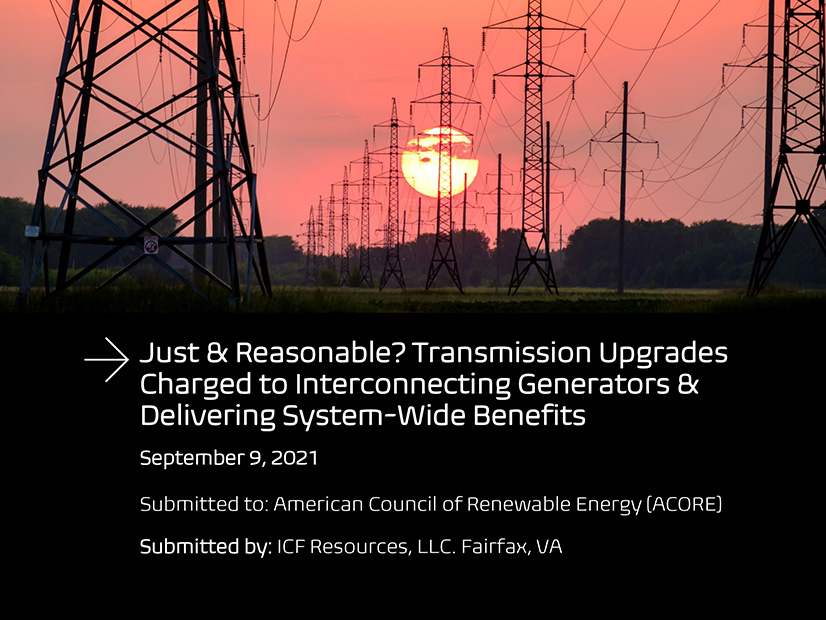
Developers of new wind and solar projects in MISO’s and SPP’s generator interconnection queues are being asked to foot nearly the entire bill when connecting to the grid, while the entire system typically benefits from significant transmission upgrades, according to an ICF Resources report released Thursday by the American Council on Renewable Energy.
ICF, a global consulting services company, said its modeling of recent network upgrades assigned to the RTOs’ new wind and solar projects found that many of these upgrades, if built, would deliver significant benefits to the grid. “The cost allocation fails to consider potential regional economic benefits from these network upgrades,” the authors wrote.
“This report confirms what many people have long believed: that network upgrades required of interconnecting generators often provide broader system benefits, even though the cost of the upgrades falls on the developers,” former FERC Chair Norman Bay, now a partner with Willkie Farr & Gallagher, said during a press event Thursday organized by ACORE.
The report, “Just and Reasonable? Transmission Upgrades Charged to Interconnecting Generators Are Delivering System-Wide Benefits,” says the RTOs’ most recent system impact studies show network upgrade costs in the range of $270 (MISO South) to $448/kW (SPP).
MISO’s most recent definitive planning phase (DPP) study for its generator interconnection queue found nearly $2.5 billion worth of upgrades were needed to interconnect 9.2 GW of generation in MISO South, according to ICF. Similarly, SPP’s most recent definitive interconnection system impact study (DISIS) identified more than $4.6 billion worth of network upgrades to help interconnect 10.4 GW of generation.

Under current cost allocation rules, project developers in both regions are responsible for paying for nearly all the upgrades’ costs, potentially violating the “beneficiary pays” principle and the Federal Power Act’s “just and reasonable” requirements. Under FERC’s “beneficiary pays” principle, RTOs are required to ensure that transmission costs are assigned at least “roughly commensurate with estimated benefits.”
The costs are assigned directly to generators in SPP. In MISO, generators are responsible for 90% of the cost for upgrades 345 kV and higher, with 10% allocated regionally. Those below the threshold pay 100%.
“At the end of the day, our customers are bearing the costs of the projects that we’re selling to them,” Matt Pawlowski, NextEra Energy’s executive director of business management and regulatory affairs, said Thursday. “If a significant amount of the upgrade costs is borne on us, we’re passing those on to the customer. Whether it’s a corporation or the ultimate end user of a utility, the ratepayers end up paying for that.”
Pawlowski and Caroline Golin, head of energy markets and policy for Google, both called for a change in RTOs’ planning practices, saying they no longer match a system that is flush with renewable energy projects.
“I think we’re being foolish if we don’t recognize we need to massively overhaul our transmission planning system. That starts with a general recognition that we are throwing money out the door by not doing that, and we are harming our community and the [renewable] industry,” Golin said.

FERC is considering whether to re-evaluate how grid operators allocate costs for new projects seeking to connect to the grid. In July, the commission opened an Advanced Notice of Proposed Rulemaking (RM21-17) to reconsider its transmission planning, cost allocation and interconnection rules. (See FERC Goes Back to the Drawing Board on Tx Planning, Cost Allocation.)
Bay called the ANOPR “timely.”
“The big tension seems to be between two principles at FERC,” he said. “On the one hand, cost causation, and on the other hand, beneficiary pays. This study shows in many instances, the beneficiary-pays principle in RTO markets is not being fully followed. This, in turn, creates a classic free-rider problem and may result in undue burden being imposed upon developers.”
SPP did not respond to the report by press time. A MISO spokesperson said the RTO is focused on its long-range transmission planning initiative and it has not reviewed the study. The grid operator has repeatedly said the plan will support the changing resource mix. (See MISO Targets March Approval for Long-term Tx Projects.)
Both RTOs are currently engaged in a joint effort to find interregional transmission projects that can help ease their crowded interconnection queues. (See MISO, SPP Offer Idea on Joint Interconnection Tx Allocation.) SPP is also involved in several initiatives to consolidate and improve its own planning process.
ICF worked closely with staff in both regions in developing the assumptions and modeling used in the report, which it produced for ACORE and its Macro Grid Initiative and American Clean Power Association collaborators.
The analysts used “very conservative” assumptions in evaluating the economic benefits of a representative sample of upgrade projects assigned through the MISO and SPP interconnection processes over the last seven years. They screened nearly 230 upgrades spanning four SPP DISIS studies (2014-2017) and 433 network upgrades covering four MISO DPP studies (2016-2020) in shortlisting six network upgrades in each RTO.
Ten of the study’s 12 network upgrades provided positive adjusted production cost benefits.
The study design, including screening process and criteria to shortlist, was shared with both RTOs’ staffs. The final set of shortlisted network upgrades was made after consultation with MISO and SPP.
